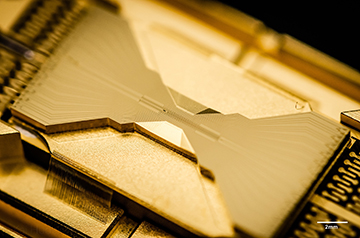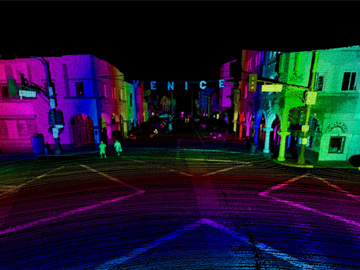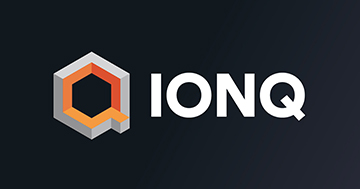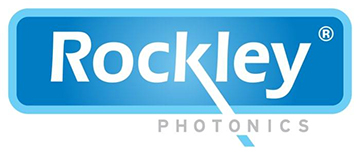
Photo of latest-generation IonQ ion trap. IonQ is one of several companies in various photonics sectors that have announced their intentions to go public via a merger with a special-purpose acquisition company (SPAC). [Image: IonQ]
Two more companies in the photonics domain recently announced their intention to go public through an increasingly popular route, so-called special-purpose acquisition companies (SPACs).
On 8 March, IonQ, a U.S.-based developer of trapped-ion quantum computers, said it had entered into a merger agreement with a SPAC, dMY Technology Group III, that would eventually bring IonQ to the public market, and thereby create what it called “the first publicly traded pure-play hardware and software company in the quantum computing space.” Eleven days later, on 19 March, Rockley Photonics, a global integrated-photonics developer, unveiled its own plans for public ownership via a merger agreement with another SPAC, SC Health Corp.
Meanwhile, two U.S.-based companies in the lidar space completed previously announced SPAC merger plans, and began trading publicly in mid-March. They join at least four other lidar firms that either have already used or plan to employ SPACs as a route to the stock market.
Popular IPO alternative

[Image: Dzmitry Dzemidovich/Getty Images]
Sometimes called a blank-check company, a SPAC is a publicly traded shell company assembled by an investment group specifically for scouting out a promising, relatively mature private company in which to invest. The SPAC first taps the public market to raise a pool of capital. Then, when it finds a private company that looks ripe for public ownership, the SPAC and the target company merge, and the targeted private company goes public through the combination with the already-listed shell company.
Going public via a SPAC tends to be less expensive and less logistically complicated than a conventional initial public offering (IPO). The SPAC pathway thus can offer private firms a comparatively easy and painless way into the public equity markets. While they have existed for years, SPACs began to go mainstream in 2019, when Richard Branson elected to take his spaceflight company Virgin Galactic public via a SPAC transaction rather than an IPO.
As rising share prices have increased the allure of going public, SPACs have become an incredibly popular way to get there. According to The Economist, an average of five SPACs were created each business day during January 2021, raising an aggregate of more than US$26 billion.
SPACs and lidar

Example of a 3D lidar point cloud from Luminar Technologies. [Image: Luminar]
For the photonics industry, SPACs have found particular favor among lidar developers. In September 2020, Velodyne Lidar completed a merger with the blank-check company Graf Industrial Corp., and entered public ownership under the ticker symbol VLDR. Three months later, Luminar Technologies went public—under the apt ticker symbol LAZR—in its own deal with another SPAC, Gores Metropoulos Inc.
In March 2021, the California-based lidar firms Aeva Inc. and Ouster Inc. both began trading publicly after completing previously announced SPAC mergers. The SPAC deal of still another lidar company, Innoviz Technologies, based in Tel Aviv, Israel, is slated to close at the end of March 2021. And a sixth lidar player, the California-headquartered AEye Inc., unveiled plans in February for a SPAC merger expected to close during the 2021 second quarter.
IonQ: Quantum computing “pure play”
The recently announced IonQ and Rockley Photonics transactions are thus interesting in part because they lie outside of the lidar market, the recent haunt of SPACs looking for photonics plays. IonQ designs and makes complex, sophisticated quantum-computing platforms based on laser-trapped ions. Rockley creates integrated-photonic chipsets for sensors and communications, with a particular eye on applications in consumer health care monitoring.

[Image: IonQ]
The planned IonQ deal will feed gross proceeds of US$650 million into the company’s coffers—US$300 million directly from the trust account of the SPAC, dMY III, and US$350 million in a so-called private investment in public equity (PIPE) by a group of nine institutional partners. US$1,275 million worth of dMY III shares will pass through as equity to existing IonQ investors.
That implies a pro forma market cap of nearly US$2 billion for the combined company, when IonQ enters the public markets under the ticker symbol IONQ. A target date for completing the merger, which still requires formal SEC and dMY III shareholder approval, wasn’t announced.
A presentation to investors outlining the deal suggested that the SPAC and PIPE funding would “enable IonQ to expand its lead, consolidate the quantum market, and attract top talent as the central company in a growing industry.” The combined financing was expected, according to the presentation, to “fund IonQ to cash flow breakeven by 2027.”
The dMY-IonQ team argued that, as “the first public pure-play quantum computing hardware and software company,” IonQ could “grow at a pace similar to previous foundational computing companies.” The CEO of the SPAC, Niccolo de Masi, said in a press release accompanying the announcement that IonQ was poised to be the first company that could fully exploit the “massive opportunity” offered by quantum computers—a market that, he asserted, could reach US$65 billion by the end of the decade.
Rockley Photonics: Eyeing consumer health care

[Image: Rockley Photonics]
The SPAC deal announced by Rockley Photonics is somewhat smaller than the planned IonQ arrangement. Rockley expects gross cash proceeds of US$173 million in trust from SPAC partner SC Health, and another US$150 million from a PIPE involving additional investors. That, coupled with rollover equity of current Rockley shareholders, and net of transaction fees and proceeds, implies a pro forma enterprise value of more than US$1.2 billion for the combined company. Rockley expects the deal to close, subject to required shareholder and SEC approvals, sometime in the second quarter of 2021.
The avowed purpose of the transaction is to accelerate the launch of a silicon-photonics-based “clinic on the wrist” sensing platform designed by Rockley to allow high-accuracy tracking of parameters such as glucose levels, blood pressure, core body temperature and other biomarkers. In a presentation to investors outlining the deal, Rockley and SC Health argued that the total addressable market for such health care monitoring devices—in wearables, mobile platforms and medical devices—could amount to an eye-watering US$48 billion or more by 2025. Rockley further argues that it offers a “full-stack solution” for this market, encompassing expertise in photonic and electronic integrated circuits, packaging, hardware and software algorithms and AI technology.
Rockley founder and CEO Andrew Rickman—who will remain on as CEO and chairman of the company after the SPAC merger—said in a press release that the company’s partnership with SC Health “positions us to accelerate our time-to-market for our compelling health and wellness solutions,” and to “deliver life-changing benefits to an enormous number of people.” On a more pecuniary note, the company also stressed that while its “immediate commercial focus” was on health care monitoring and medical technology, its platform also has “additional avenues for growth” in data communications, machine vision and computing.
